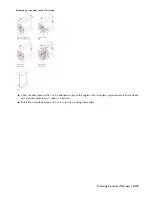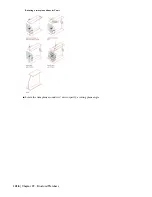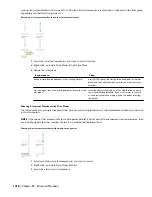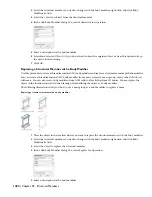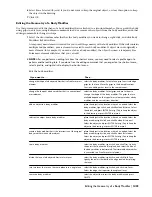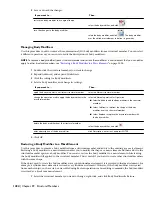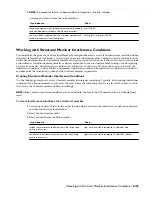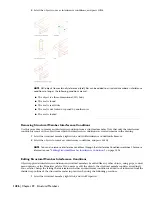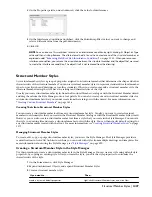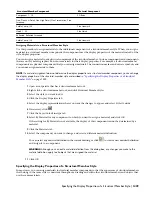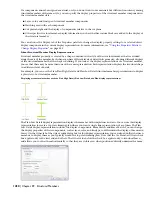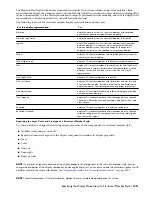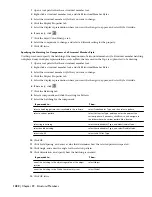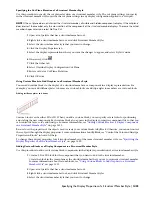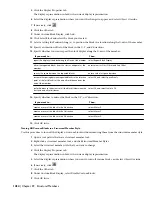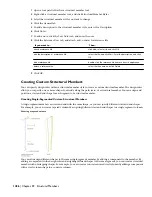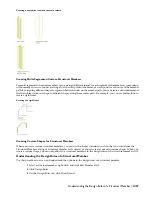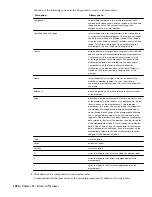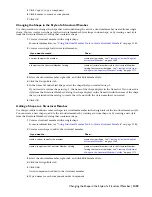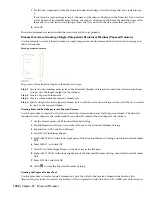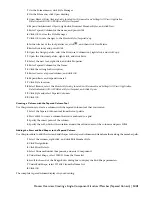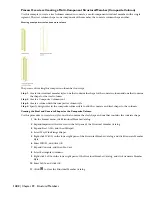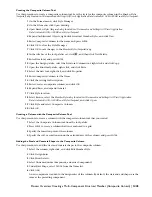
Then…
If you want to…
right-click the structural member style you want to copy, and
click Copy. Right-click, and click Paste.
create a style from an existing style
4
Enter a name for the new structural member style, and press
ENTER
.
5
Edit the new structural member style:
Then…
If you want to…
click the General tab, and enter a description.
enter a description of the style
click the Design Rules tab, and select or clear Trim Members
Automatically. This option is selected by default for new styles.
The setting can be overridden in the tool or object properties.
specify whether a member with this style will automatically
trim to existing members when added to a drawing and
whether its trim planes will be adjusted automatically if it is
grip edited directly, or if its endpoints move in response to
grip-editing of a logically connected member
see
“
Creating Custom Structural Members
” on page 1436
.
change the design rules of the style to create a custom
structural member
see
“
Specifying the Materials of a Structural Member Style
”
on page 1428
.
specify materials for the components of the style
see
“
Specifying the Display Properties of a Structural
Member Style
” on page 1429
.
specify hatching, cut plane properties, and other display
properties of the style
see
“
Specifying Classifications for a Structural Member
Style
” on page 1435
.
add classifications to a structural member style
see
“
Attaching Notes and Files to a Structural Member
Style
” on page 1435
.
add notes and files to the style
6
Click OK.
7
If you want to assign the style to a structural member tool, drag the style from the Style Manager to a tool
palette.
You can later rename the tool and specify other properties for it as described in “
Creating Structural Member
Tools
” on page 1377.
8
Click OK.
Specifying the Materials of a Structural Member Style
A structural member consists of a number of components whose display properties can be determined by the materials
assigned to each component. When you assign materials to a structural member style, you assign one material to each
physical component of the structural member. You assign materials to components in each display representation
where you want the materials to be used.
If you want to use the display properties of the structural member style, instead of using material display properties,
you can turn off the material assignments in the display properties of the structural member style.
Material definitions consist of display components that correspond to component types of objects. For example, the
Linework component of a material is used for all linework in plan view. The Surface Hatch component of a material is
used to hatch all object surfaces in three dimensional (3D) model views and in elevations.
Structural Member Materials and Display Components
The following table identifies the material component that corresponds to each structural member component:
Material Component
Structural Member Component
Elevation, Elevation High Detail
Plan Linework
Visible Comp 1-10
Model, Model High Detail, Model Low Detail
1428 | Chapter 29 Structural Members
Summary of Contents for 00128-051462-9310 - AUTOCAD 2008 COMM UPG FRM 2005 DVD
Page 1: ...AutoCAD Architecture 2008 User s Guide 2007 ...
Page 4: ...1 2 3 4 5 6 7 8 9 10 ...
Page 40: ...xl Contents ...
Page 41: ...Workflow and User Interface 1 1 ...
Page 42: ...2 Chapter 1 Workflow and User Interface ...
Page 146: ...106 Chapter 3 Content Browser ...
Page 164: ...124 Chapter 4 Creating and Saving Drawings ...
Page 370: ...330 Chapter 6 Drawing Management ...
Page 440: ...400 Chapter 8 Drawing Compare ...
Page 528: ...488 Chapter 10 Display System ...
Page 540: ...500 Chapter 11 Style Manager ...
Page 612: ...572 Chapter 13 Content Creation Guidelines ...
Page 613: ...Conceptual Design 2 573 ...
Page 614: ...574 Chapter 14 Conceptual Design ...
Page 678: ...638 Chapter 16 ObjectViewer ...
Page 683: ...Designing with Architectural Objects 3 643 ...
Page 684: ...644 Chapter 18 Designing with Architectural Objects ...
Page 788: ...748 Chapter 18 Walls ...
Page 942: ...902 Chapter 19 Curtain Walls ...
Page 1042: ...1002 Chapter 21 AEC Polygons ...
Page 1052: ...Changing a door width 1012 Chapter 22 Doors ...
Page 1106: ...Changing a window width 1066 Chapter 23 Windows ...
Page 1172: ...1132 Chapter 24 Openings ...
Page 1226: ...Using grips to change the flight width of a spiral stair run 1186 Chapter 25 Stairs ...
Page 1368: ...Using the Angle grip to edit slab slope 1328 Chapter 28 Slabs and Roof Slabs ...
Page 1491: ...Design Utilities 4 1451 ...
Page 1492: ...1452 Chapter 30 Design Utilities ...
Page 1536: ...1496 Chapter 31 Layout Curves and Grids ...
Page 1564: ...1524 Chapter 32 Grids ...
Page 1611: ...Documentation 5 1571 ...
Page 1612: ...1572 Chapter 36 Documentation ...
Page 1706: ...Stretching a surface opening Moving a surface opening 1666 Chapter 36 Spaces ...
Page 1710: ...Offsetting the edge of a window opening on a freeform space surface 1670 Chapter 36 Spaces ...
Page 1956: ...1916 Chapter 42 Fields ...
Page 2035: ...Properties of a detail callout The Properties of a Callout Tool 1995 ...
Page 2060: ...2020 Chapter 45 Callouts ...
Page 2170: ...2130 Chapter 47 AEC Content and DesignCenter ...
Page 2171: ...Other Utilities 6 2131 ...
Page 2172: ...2132 Chapter 48 Other Utilities ...
Page 2182: ...2142 Chapter 51 Reference AEC Objects ...
Page 2212: ...2172 Chapter 52 Customizing and Adding New Content for Detail Components ...
Page 2217: ...AutoCAD Architecture 2008 Menus 54 2177 ...
Page 2226: ...2186 Chapter 54 AutoCAD Architecture 2008 Menus ...
Page 2268: ...2228 Index ...


